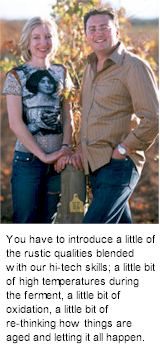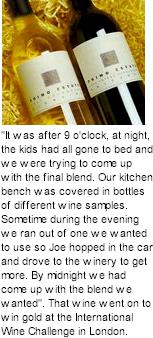


Only 3 kilometres from the coast, Virginia enjoys the benefits of the cool sea breezes that sweep over the plains in the evenings. Primo built his vineyard with passion and understood completely the life of a vine. The grapes were grown to be turned into wine. His eldest son Joseph grew up with the vines tending them with the rest of the family. Joseph was to be a winemaker. It was not a conscious choice, not an expectation, just a progression, what he had to be. From his very first vintage, at age 20, Primo Estate's Joe Grilli wanted to create revolutionary wines. Ever since, Joe has been doing exactly that; creating some wonderfully dazzling and unconventional wines under the Joseph and Primo Estate labels.

In 1979 Joseph completed his oenology course at Roseworthy Agricultural College and this coincided with the first vintage of Primo Estate. At this time the Australian wine industry was experiencing a renaissance and was leading the world with the new technology of winemaking. Joseph embraced these ideas. His dreams and passion, however, were the great wine styles of the world. He was consumed with his role as winemaker and from the outset used innovative techniques such as double pruning to make his wine.
"The vines were 6 years old when we started our first vintage. They were pretty dark times back then in the 70s. You couldn't give red wine away. People only wanted to drink riesling which, fortunately we had a fair bit of!" In 1981 Joseph made a wine that is the epitome of Primo Estate. He was enchanted with traditional German sweet whites and longed to make a similar style. A modern method was used to craft a luscious botrytis Riesling. The 1981 Primo Estate Beerenauslese was one of the first of its kind in Australia.
The success of this wine gave Joseph the confidence to experiment with other methods and non-traditional grape varieties. The Primo Estate la biondina is another success story. Harvesting of the Colombard grape is always eagerly awaited. The fermenting grapes produce heady smells in the winery, turning into a wine that is released young and fresh that almost jumps out of the glass.

In 1987 Joseph with his wife Dina travelled the wine regions of France and Italy. They were taken with the magic of these countries and saw and tasted much of their beauty. They returned after many adventures full of enthusiasm to continue to create their own brand of magic. A new wine was introduced into their range. This time using a traditional Italian method to create a wine with modern breeding. The 1987 'Moda' Cabernet Sauvignon Merlot heralded a new label Joseph and a new beginning.
Working the vintage in Bordeaux Joe and Dina learned about attitude in wine making. What they discovered was considered equally as important as good soil, good climate and good grapes. Wine must, according to those Bordeaux winemakers, be made with serenity. This philosophy was driven home even further when the Grillis' worked two vintages in Italy a few years later. Primo Estate's Il Briccone (the rogue) is a medium weight blend of shiraz and sangiovese with small amounts of barbera and nebbiolo. "This wine has become a major project for us", enthused Joe. Even if people don't know anything about Italian reds I want them to be able to just drink it and enjoy, we want it to parallel our La Biondina, (the little blonde) -our colombard -I know people love drinking that whether they are a wine connoisseur or not."
Primo Estate also have a vineyard just out of Clarendon at Angel Gully. Clarendon is sandwiched between Adelaide and McLaren Vale in an area where you can hardly find any dirt on which to plant vineyards. It's a very hilly and a difficult viticultural area, cooler than McLaren Vale but not as cool as the Central Adelaide Hills. Does the life of the winemaker ever get monotonous? "Never! Each vintage is different - you never know what is going to happen. It's a great lifestyle", says Dina Grilli.
